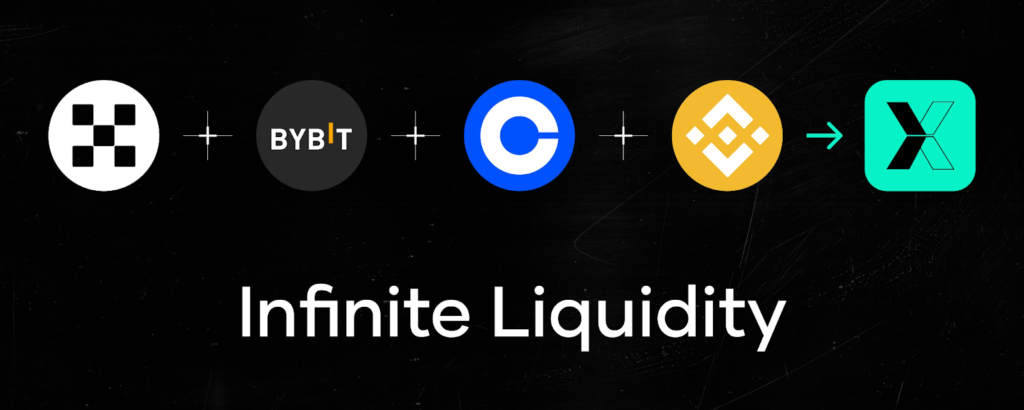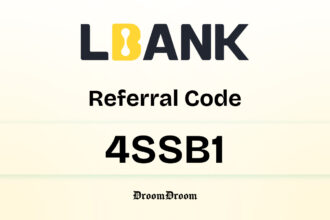Most traders face the constant struggle with fragmented liquidity and high slippage. Whether trying to execute large trades or move assets across different chains, the hurdles are endless.
- How Infinite Liquidity Works
- What Are the Benefits of Infinite Liquidity for Traders?
- Slippage Reduction and Price Stability
- Efficient Trade Execution for Large Transactions
- Faster Execution and Lower Transaction Costs
- Better Price Discovery
- Access to Diverse Assets
- Use Cases of Infinite Liquidity in DeFi
- Perpetual Trading
- Real-World Asset (RWA) Trading
- Meme Coin and New Token Launches
- Leveraged Prediction Markets
- Conclusion
Switching between multiple platforms, connecting various wallets, and paying hefty gas fees just to complete a simple transaction is not just frustrating—it’s inefficient and costly. Even the rise of decentralized solutions hasn’t fully tackled this core problem, as they typically pull liquidity from a single source or blockchain, leaving gaps and price inconsistencies.
This is where the concept of infinite liquidity will come handy. But what does “infinite liquidity” mean in DeFi and how does it differ from traditional liquidity models?
Infinite liquidity in DeFi refers to the ability to execute trades without encountering huge price slippage or liquidity shortages. It means that traders can buy or sell assets in large quantities without the market being disrupted or the price being skewed due to low liquidity.
This doesn’t mean the liquidity is literally infinite. Instead, it signifies that liquidity is pooled from multiple sources to simulate the feeling of always having liquidity available.
LogX Network has pioneered this concept by aggregating liquidity from centralized exchanges (CEXs) like Binance, Coinbase, and OKX. Ultimately they are offering a decentralized trading experience with the liquidity depth of centralized platforms.
How Infinite Liquidity Works
The LogX Network has built the world’s first infinite liquidity model by aggregating liquidity from top CEXs and offering this depth to DeFi users. The network is a purpose-built Layer 2 solution with a vision to be the “DeFi Superapp.”
Infinite liquidity in DeFi is powered by a combination of technologies—most importantly liquidity aggregation, cross-chain interoperability and off-chain hedging. Let’s break these concepts down in simple terms, shall we?
Liquidity Aggregation
Liquidity aggregation is the process of combining buy and sell orders from multiple sources to facilitate trading.
In LogX, liquidity is aggregated from top-tier CEXs such as Binance and OKX to provide deeper liquidity than any individual decentralized exchange (DEX) could offer.

Cross-Chain Interoperability
An important aspect of LogX’s infinite liquidity model is cross-chain interoperability. By operating across multiple blockchain networks—including Layer 2 solutions like Arbitrum, Mantle, and Fuse—LogX allows users to trade seamlessly across different ecosystems without switching platforms.
Undoubtedly, this design reduces liquidity fragmentation and ensures that liquidity is pooled not just from one source, but from across different chains and centralized exchanges.
Off-Chain Hedging
In traditional finance, liquidity comes from centralized sources like market makers or brokers who can only handle limited volumes. In contrast, LogX’s infinite liquidity model aggregates liquidity from multiple exchanges to ensure that there is always enough depth to handle large trades.
LogX uses solvers, professional market makers (MMs) who source liquidity and hedge off-chain.
Solvers make infinite liquidity possible by aggregating liquidity dynamically from centralized exchanges. They help overcome the liquidity fragmentation problem in DeFi by providing consolidated liquidity from CEXes.
When a trader submits a request, these solvers stream real-time quotes from multiple CEXs and compete to offer the best price. This whole process makes it certain that trades are executed at the most favorable rate while reducing slippage (the difference between the expected price of a trade and the price at which it is executed).
After sourcing the liquidity and executing the trade, solvers hedge off-chain, meaning they manage their risk and exposure on the centralized exchanges. This helps to balance open interest (the amount of outstanding contracts) without affecting on-chain liquidity.
What Are the Benefits of Infinite Liquidity for Traders?
Infinite liquidity offers several key benefits for traders which makes it especially useful in decentralized finance—
Slippage Reduction and Price Stability
Slippage usually occurs when there is low market liquidity or high volatility. When a large order is placed, it often causes the price to shift unfavorably due to a lack of liquidity.
Infinite liquidity eliminates this issue by making sure that there is always enough liquidity to absorb large orders without causing price instability. LogX bridges the dispersed liquidity gap by offering a model that aggregates liquidity from multiple CEXs rather than relying on fragmented on-chain pools.
Efficient Trade Execution for Large Transactions
Large trades, often referred to as whale transactions, can significantly impact the market on platforms with limited liquidity.
With LogX’s infinite liquidity model, such trades can be executed efficiently because of the large liquidity pools sourced from multiple CEXs. Then, naturally, traders can place huge orders without the fear of their trades affecting the overall market price.
Faster Execution and Lower Transaction Costs
Because solvers compete in real-time to offer the best prices, it only makes sense that LogX’s system will make sure of faster trade execution.
With this, the aggregation of liquidity from multiple sources reduces the need for high fees typically charged by liquidity providers. This makes the entire trading process more cost-effective for traders.
Better Price Discovery
In efficient markets, increased trader participation leads to greater liquidity and trading volume. This positive feedback loop encourages even more traders to join — enhancing market efficiency even more.
Ultimately the advantage is better price discovery, where the true value of assets can be revealed more accurately because the market is constantly liquid and active.
Access to Diverse Assets
In traditional markets or in fragmented DeFi platforms, certain assets may lack liquidity, making it difficult to execute trades without affecting the price.
Infinite liquidity solves this problem by ensuring that traders can buy or sell a diverse range of assets easily, whether it’s popular cryptocurrencies, real-world assets (RWAs), tokenized commodities, or even exotic financial instruments like binary options.
When asked about the core principles behind LogX’s infinite liquidity model and how the team ensures its scalability and reliability as DeFi evolves, Akshit Bordia, co-founder of LogX Network communicates saying,
At LogX, we’re committed to making sure our infinite liquidity model grows with the market. We pull liquidity from top CEXs like Binance and OKX to ensure deep liquidity, while our solver model keeps trades smooth, even during large transactions. Cross-chain support is key for reducing fragmentation and boosting scalability.
Our focus is on innovation, partnering with leaders like Arbitrum to keep trading fast, gasless, and seamless for our users. Ultimately, it’s about building a platform that scales as DeFi scales.
Akshit Bordia, co-founder of LogX Network
Use Cases of Infinite Liquidity in DeFi
Infinite liquidity has a wide range of use cases in DeFi. Here are a few key sectors where LogX’s model stands out but mind you there are lots more—
Perpetual Trading
LogX offers perpetual contracts across multiple networks. This allows traders to leverage infinite liquidity in order to trade derivatives seamlessly, even across highly volatile markets. With support for over 100 perpetual pairs, including exotic markets, LogX provides liquidity solutions that rival traditional exchanges.
Real-World Asset (RWA) Trading
LogX is pioneering on-chain real estate trading by tokenizing real-world assets. Infinite liquidity ensures that these assets can be traded without liquidity concerns, offering a transparent and efficient way to trade RWAs on-chain.
Meme Coin and New Token Launches
For meme coin launches or new token offerings, liquidity is critical for preventing price volatility. With LogX’s infinite liquidity model, new tokens can be launched with sufficient liquidity, ensuring a smooth and stable trading environment.
Leveraged Prediction Markets
LogX enables users to participate in leveraged prediction markets, where traders can take positions on real-world events like elections or sports with up to 20x leverage. This innovative use case allows for high-risk, high-reward opportunities, backed by the deep liquidity sourced from multiple centralized exchanges.
Conclusion
Fragmentation and shallow liquidity have long been thorns in the side of DeFi. Then we come across Infinite liquidity, the ingenious concept that bridges the gap between DeFi’s boundless potential and the limitations of on-chain liquidity pools.
LogX Network’s infinite liquidity model is about smart aggregation, leveraging the vast reserves of centralized exchanges to create the illusion of a bottomless liquidity pool. This isn’t just about smoother trades; it’s about unfastening a new dimension of DeFi possibilities.
Infinite liquidity opens the door for a future of DeFi that’s not just innovative, but truly inclusive, empowering everyone from retail traders to prediction market mavericks.
Of course, there’s always the other side of the coin.
Centralization is a double-edged sword, and relying on CEX liquidity introduces a layer of trust. But when the alternative is fragmented, frustrating DeFi, infinite liquidity offers a compelling proposition. As the technology matures, the lines between CEX and DEX may well blur, creating a future where DeFi inherits the best of both worlds.



















